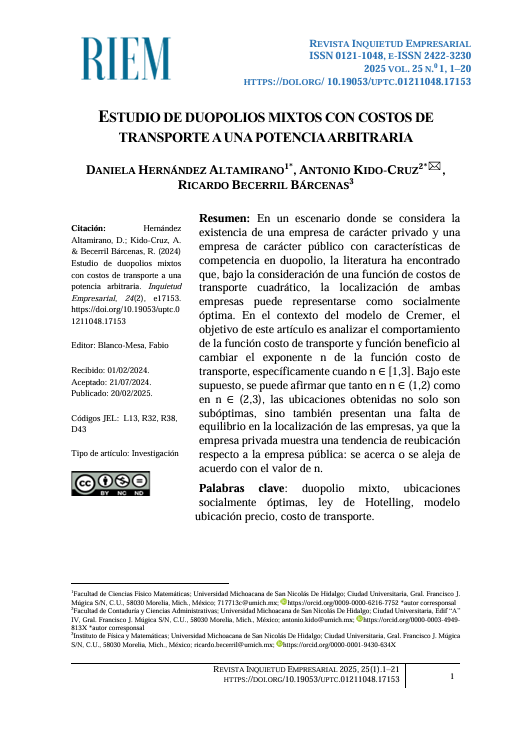Study of mixed duopolies with transportation costs at an arbitrary power

Abstract
In a mixed duopoly market with a private company and a public company, the literature has found that, under the consideration of a quadratic transportation cost function, the location of both companies can be represented as socially optimal. In the context of the Cremer model, the purpose of this paper is to analyze the behavior of the transportation cost function and benefit function when changing the exponent n of the transportation cost function, specifically when n ∈ [1,3]. Under this assumption it can be stated that both in n ∈ (1,2) and in n ∈ (2,3) the locations obtained are not only suboptimal, but also present a lack of equilibrium, since the private company shows a tendency of relocation with respect to the public company: it moves closer or further away according to the value of n.
JEL Codes: L13, R32, R38, D43
Received: 01/02/2024. Accepted: 21/07/2024. Published: 20/02/2025.
Keywords
Mixed duopoly, socially optimal locations, Hotelling's law, location price model, transportation cost
References
- Anderson, S. P. (1988). Equilibrium existence in the linear model of spatial competition. Economica, 220(55), 479–491. https://doi.org/10.2307/2553910 DOI: https://doi.org/10.2307/2553910
- Andree, K., Heywood, J. S., Schwan, M., & Wang, Z. (2018). A spatial model of cartel stability: the influence of production cost convexity. Bulletin of Economic Research, 70(3), 298–311. https://doi.org/10.1111/boer.12149 DOI: https://doi.org/10.1111/boer.12149
- Bárcena-Ruiz, J. C., & Casado-Izaga, F. J. (2012). Location of public and private firms under endogenous timing of choices. Journal of Economics/Zeitschrift fur Nationalokonomie, 105(2), 129–143. https://doi.org/10.1007/s00712-011-0228-6 DOI: https://doi.org/10.1007/s00712-011-0228-6
- Cremer, H., Marchand, M., & Thisse, J. F. (1991). Mixed oligopoly with differentiated products. International Journal of Industrial Organization, 9(1), 43–53. https://doi.org/10.1016/0167-7187(91)90004-5 DOI: https://doi.org/10.1016/0167-7187(91)90004-5
- D’aspremont, C., Jaskold Gabszewicz, J., & Thisse, J.-F. (1979). On Hotelling’s “Stability in Competition”. Econometrica, 47(5), 1145–1150. https://doi.org/10.2307/1911955 DOI: https://doi.org/10.2307/1911955
- Dragone, D., & Lambertini, L. (2020). Equilibrium existence in the Hotelling model with convex production costs. Regional Science and Urban Economics, 84, 103568. https://doi.org/10.1016/J.REGSCIURBECO.2020.103568 DOI: https://doi.org/10.1016/j.regsciurbeco.2020.103568
- Drezner, T., & Drezner, Z. (2016). Sequential location of two facilities: comparing random to optimal location of the first facility. Annals of Operations Research, 246, 5–18. https://doi.org/10.1007/s10479-014-1699-y DOI: https://doi.org/10.1007/s10479-014-1699-y
- Economides, N. (1984). The principle of minimum differentiation revisited. European Economic Review, 24(3), 345–368. https://doi.org/10.1016/0014-2921(84)90061-8 DOI: https://doi.org/10.1016/0014-2921(84)90061-8
- Economides, N. (1986). Minimal and maximal product differentiation in Hotelling’s duopoly. Economics Letters, 21(1), 67–71. https://doi.org/10.1016/0165-1765(86)90124-2 DOI: https://doi.org/10.1016/0165-1765(86)90124-2
- Economides, N. (1989). Quality variations and maximal variety differentiation. Regional Science and Urban Economics, 19(1), 21–29. https://doi.org/10.1016/0166-0462(89)90031-8 DOI: https://doi.org/10.1016/0166-0462(89)90031-8
- Fernández-Ruiz, J. (2020). Mixed duopoly in a Hotelling framework with cubic transportation costs. Letters in Spatial and Resource Sciences, 13(2), 133–149. https://doi.org/10.1007/s12076-020-00249-y DOI: https://doi.org/10.1007/s12076-020-00249-y
- Flores-Curiel, D., Cárdenas-Rodríguez, O. J., y Arteaga-García, J. C. (2004). Privatización: ¿Suben o bajan los precios? Duopolio mixto con diferenciación vertical. Estudios Económicos, 19(2), 141-157.
- Heywood, J. S., Li, D., & Ye, G. (2022). Mixed duopoly under hotelling with convex production costs. Annals of Regional Science, 69(2), 487–510. https://doi.org/10.1007/s00168-022-01144-8 DOI: https://doi.org/10.1007/s00168-022-01144-8
- Hotelling, H. (1929). Stability in Competition. The Economic Journal, 39 (153), 41-57. https://doi.org/10.2307/2224214 DOI: https://doi.org/10.2307/2224214
- Li, C. (2006). Location choice in a mixed oligopoly. Economic Modelling, 23(1), 131–141. https://doi.org/10.1016/J.ECONMOD.2005.09.002 DOI: https://doi.org/10.1016/j.econmod.2005.09.002
- Ma, H., Wang, X. H., & Zeng, C. (2021). Location choice and costly product differentiation in a mixed duopoly. Annals of Regional Science, 66, 137–159. https://doi.org/10.1007/s00168-020-01014-1 DOI: https://doi.org/10.1007/s00168-020-01014-1
- Matsumura, T., & Tomaru, Y. (2013). Mixed duopoly, privatization, and subsidization with excess burden of taxation. Canadian Journal of Economics, 46(2), 526–554. https://doi.org/10.1111/caje.12022 DOI: https://doi.org/10.1111/caje.12022
- Park, J., & Moon, I. (2023). A facility location problem in a mixed duopoly on networks. Transportation Research Part E: Logistics and Transportation Review, 175, 103149. https://doi.org/10.1016/J.TRE.2023.103149 DOI: https://doi.org/10.1016/j.tre.2023.103149
- Ridley, D. B. (2016). Hotelling’s Law. The Palgrave Encyclopedia of Strategic Management (pp. 1–2). Palgrave Macmillan. https://doi.org/10.1057/978-1-349-94848-2_421-1 DOI: https://doi.org/10.1057/978-1-349-94848-2_421-1
- Rittenberg, L. (2008). Principles of Microeconomics (2nd ed.). FlatWorld
- Sanz, G. A. (1988). Empresa pública y mercados oligopolísticos: análisis de las reglas de maximizar el beneficio y precio igual a coste marginal. Cuadernos de Economía, 16(1), 205–2113.
- Thomas, G. B., Finney, R. L., & Weir, M. D. (1992). Calculus and Analytic Geometry (9th ed.). Addison-Wesley Publishing Company.
- Zhou, G., Zhu, Z., & Luo, S. (2022). Location optimization of electric vehicle charging stations: Based on cost model and genetic algorithm. Energy, 247, 123437. https://doi.org/10.1016/J.ENERGY.2022.123437 DOI: https://doi.org/10.1016/j.energy.2022.123437
